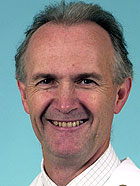Peter Westervelt, M.D., Ph.D., has been named director of the bone marrow transplantation and leukemia section of the Division of Oncology at the School of Medicine.
Westervelt, associate professor of medicine, succeeds John F. DiPersio, M.D., Ph.D., professor of medicine, in the position. DiPersio continues his positions as chief of the Division of Oncology and deputy director of the Siteman Cancer Center.

Westervelt completed the M.D./Ph.D. program at the medical school in 1992 and then completed his residency and fellowship here. After two years as an instructor in medicine at WUSTL, Westervelt returned to his native New England to take a position as director of the Bone Marrow Transplantation Program at the University of Massachusetts Medical School in Worcester.
“Dr. DiPersio asked if I would consider coming back to Washington University to run the bone marrow program,” Westervelt said. “He had built this program from the ground up over the last 10 years and made it into one of the top five programs in the country. For me it represented an unbelievable opportunity to join a great program — a program I’m very familiar with — and a group of wonderful people.”
Westervelt said the large number of patients treated in the section allows the program to perform single-institution clinical trials and provides access to a wide range of tissue samples for banking and future study. Paired with outstanding basic science expertise in the division in stem cell biology and leukemia research, the size of the program greatly facilitates translational research, which brings ideas from the scientist to the bedside.
“It’s personally gratifying and tremendously exciting for all of us to have succeeded in recruiting Peter back to Washington University,” DiPersio said. “He’s not only a physician trained here, but also someone who has advanced to national stature in the fields of leukemia and transplantation. He will carry the section forward to new heights.”
Westervelt said he would strive to continue to enhance the quality of care delivered by the section and work to recruit additional physicians to a program that now has four full-time clinical faculty members and three members who are primarily laboratory-based.
Bone marrow transplantation was developed to treat leukemia, which remains one of the major conditions it is used for, Westervelt said. But bone marrow and stem cell transplantations are also established indications for the treatment of other hematologic malignancies such as lymphoma and multiple myeloma and is also used for some nonmalignant conditions such as aplastic anemia and sickle cell anemia.
Research in the section focuses on reducing the toxicity of the transplantation procedure by decreasing the incidence or severity of graft vs. host disease, understanding how transplanted cells help fight leukemia cells to cure cancer and developing new therapies for hematologic malignancies.
“I worked in the lab when I was a fellow, and subsequently at the University of Massachusetts, developing models of acute leukemia in mice,” Westervelt said. “That has given me an understanding of leukemia at the molecular level, which is a valuable platform for treating patients with leukemia and developing new treatments. The experience of working in a really top-quality lab continues to pay dividends.”